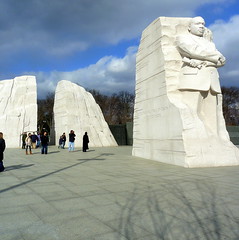Who gets remembered, and how we remember them, isn’t left to chance. Images of the past are malleable, and memories are often altered and changed based on present-day events and actors.
Today, many are remembering Martin Luther King Jr. And as CNN points out, some ways of remembering, like the new Martin Luther King Jr. memorial, are quite controversial.
The man himself was controversial, notes LaSalle University sociology professor Charles Gallagher. King — bound up with issues of racial and economic inequality that spotlight America’s worst sins — is a “Rorschach test,” Gallagher says, that people see in King what they want to see.
Still, few of the organizers of the Martin Luther King Jr. National Memorial in Washington may have expected that every little detail would be so scrutinized, criticism that has continued right up to the first Martin Luther King Jr. Day since it opened last fall.
Just last Friday, the Department of the Interior announced that a quotation on the memorial would be changed. The quotation, which was paraphrased from one of his sermons, reads “I was a drum major for justice, peace and righteousness.” The longer passage was premised on a conditional that began, “If you want to say that I was a drum major, say that I was a drum major for justice.” Critics argued that the quote was taken out of context and makes King appear arrogant.
Indeed, King isn’t the first luminary to have a quotation misused. The Jefferson Memorial, across the Tidal Basin “juxtaposes fragments (of Jefferson’s writings) … to create the impression that he was very nearly an abolitionist,” writes historian James Loewen, author of “Lies My Teacher Told Me.”
The memorial was also criticized for freezing a person in stone, something that certainly isn’t unique to this memorial.
Sculptor Daniel Chester French’s Abraham Lincoln, across the Mall, is a gorgeous work, but he is now brooding for all eternity. Franklin D. Roosevelt, nearby, was originally represented by a statue apparently based on the weary president at Yalta; a second FDR, showing him in a wheelchair, was added after protests.
So how is King remembered, and why does it matter? Check out the complete CNN article for a thoughtful discussion that draws on the insights of sociologists, public health professors, and historians.


Comments